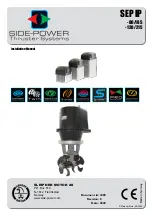NXP Semiconductors
KTFRDMHB2001FEVMUG
FRDM-HB2001FEVM evaluation board
KTFRDMHB2001FEVMUG
All information provided in this document is subject to legal disclaimers.
© NXP B.V. 2016. All rights reserved
User guide
Rev. 1.0 — 25 May 2016
12 / 35
Name
Signal
Jumper
position
Connection
1−2
VDD connected to VDDQ
J14
VDDQ
2−3
VDDQ not connected
1−2
V
DD
supply from regulator U2
J17
VDD
2−3
V
DD
supply from FRDM board
J18
CFB_R
1−2
CFB connected to MCU ADC input J10 Pin 17 (CFB_READ)
J19
FS_B
1−2
FS_B connected to the pull-up resistor
J26
VDD_REG
1−2
V
DD
to FRDM board
J15
EX_IN
Open
IN1 and IN2 external inputs
The FRDM-HB2001FEVM, in conjunction with a FRDM-KL25Z board (shipped with the
kit), can evaluate the design by means of a GUI, any MCU with GPIO or with simple lab
equipment. A FRDM-KL25Z-compatible GUI and MCU program are available online at
the following link:
http://www.nxp.com/FRDM-HB2001FEVM
.
The FRDM-HB2001FEVM is compatible with any Arduino
™
platform board. However, if
a board other than the FRDM-KL25Z is used, MCU code must be written to work with the
board.
4.4.3 Input signal definitions
The following input signals control the outputs or functions inside the circuit.
Table 5. Input signal definitions
Input name
Description
DIS
Disable signal to tri-state the outputs
ENBL
Disable signal to tri-state the output and put the part in Sleep mode
IN1
Logic input to control OUT1
IN2
Logic input to control OUT2
MOSI
Master out slave input for the SPI
CS_B
Chip select bar input for the SPI
SCLK
Clock for the SPI
4.4.4 Output signal definitions
The FRDM-HB2001-FEVM uses the following output signals to drive a load such as
a brushed DC motor. The board provides an analog output for real time load current
monitoring. This signal allows closed loop control of the load.
Table 6. Output signal definitions
Output name
Description
OUT1
Output 1 of H-Bridge
OUT2
Output 2 of H-Bridge
FS_B
Open drain Active Low status flag output to indicate fault

















